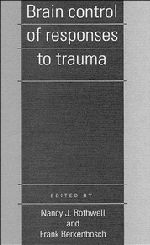Book contents
- Frontmatter
- Contents
- Contributors
- 1 Introduction
- 2 Responses to injury
- 3 Experimental approaches to the central nervous system control of responses to trauma
- 4 Neurohormonal control of cytokines during injury
- 5 Brain regions involved in modulation of immune responses
- 6 Psychological and neurobiological consequences of trauma
- 7 Central nervous system control of sickness behavior
- 8 Psychological and behavioural aspects of pain
- 9 Central control of cardiovascular responses to injury
- 10 Neuroendocrine responses to physical trauma
- 11 Central control of metabolic and thermoregulatory responses to injury
- 12 Central control of pain
- 13 The final word …
- Index
2 - Responses to injury
Published online by Cambridge University Press: 05 August 2016
- Frontmatter
- Contents
- Contributors
- 1 Introduction
- 2 Responses to injury
- 3 Experimental approaches to the central nervous system control of responses to trauma
- 4 Neurohormonal control of cytokines during injury
- 5 Brain regions involved in modulation of immune responses
- 6 Psychological and neurobiological consequences of trauma
- 7 Central nervous system control of sickness behavior
- 8 Psychological and behavioural aspects of pain
- 9 Central control of cardiovascular responses to injury
- 10 Neuroendocrine responses to physical trauma
- 11 Central control of metabolic and thermoregulatory responses to injury
- 12 Central control of pain
- 13 The final word …
- Index
Summary
Historical aspects
Injury is such a frequent occurrence that its effects must have been among the earliest of the biological responses to have been investigated. Indeed, the salient features of the local response, inflammation, have been known from the time of Celsus (quoted by Majno, 1964) in the first century A.D. Realisation that there was a general response by the body to a local injury came later and was probably first described by Pare in 1582. Pare was a military surgeon, and later advances have almost always been linked to warfare. For most of the time injury and its effects can be conveniently ignored by doctor and lay-person alike but in wartime it obtrudes on general consciousness. Hence, our appreciation of these responses was advanced by military surgeons such as Clowes (1591), Hunter (1794), Guthrie (1815) and above all by Larrey (see Dible, 1970), who laid the foundations for the modern treatment of trauma.
Despite numerous conflicts, progress since the work of Larrey has been extremely slow for, although it was realised that injury provoked a response by the body, little attempt was made to understand the coordination of the response.
Causation of'shock'
Much of the time between the two World Wars was spent in the search for a single cause for what was usually called shock'. This term was probably first used in the English literature by Latta (1795) but has never been clearly defined (Grant & Reeve, 1951). Three candidates were considered as possible causes - fluid loss, toxic factors and nervous influences. The last of these had been introduced by Crile (1899), who sought to explain the cardiovascular decline of the injured patient byfatigue of the nervous centres involved. This was soon dismissed and interest in the later attempts by O'Shaughnessy & Slome (1934; Slome & O'Shaughnessy, 1938) and by Overman & Wang (1947) to determine the role of the afferent nervous barrage from the injured tissue was short lived. The main argument was between fluid loss and toxic factors and was generally thought to have been decided by Blalock (1931) in favour of fluid loss - either externally as in haemorrhage or internally as in the oedema around damaged tissue.
- Type
- Chapter
- Information
- Brain Control of Responses to Trauma , pp. 3 - 21Publisher: Cambridge University PressPrint publication year: 1994



